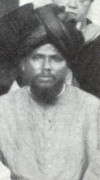S. Ramaswamier
According to Readers Guide to The Mahatma Letters to A. P. Sinnett:
Ramaswamier, S. (Ramabadra), a prominent South Indian who joined the TS in 1881 and became a chela of M. He died in 1893. Best known in TS literature for his account of his trip to Sikkim on October 5-7, 1882, to visit M and KH in person, which was a very special occasion for a chela of such short training. He wrote to DKM about the trip (D, p. 289). ML, p. 437; BTT, p. 405; OW, 221; HPB VI: 21.[1]
Encounters Mahatma M.
By the end of September 1882, Ramaswamier was in Darjeeling, India, with Mme. Blavatsky. This was not far from the borders of Sikkim, beyond which was Tibet. Early in October he "determined, come what might, to cross the frontier, which is about a dozen miles from here, and find the Mahatmas, or—DIE". After walking for one day and resting through the night, he resumed his journey, on the morning of October 6:
It was, I think, between eight and nine am, and I was following the road to the town of Sikkim, whence, I was assured by the people I met on the road, I could cross over to Tibet easily in my pilgrim's garb when I suddenly saw a solitary horseman galloping towards me from the opposite direction. From his tall stature and the expert way he managed the animal, I thought he was some military officer of the Sikkim Raja. Now, I thought, am I caught. But as he approached me, he reined the steed. I looked at and recognized him instantly. I was in the presence of my own revered Guru. The very same instant saw me prostrated on the ground at his feet. I arose at his command and, leisurely looking into his face, I forgot myself entirely. I knew not what to say: joy and reverence tied my tongue. I was at last face to face with "the Mahatma of the Himavat" and he was no myth. It was no night dream; it is between nine and ten o'clock of the forenoon. There is the sun shining and silently witnessing the scene from above.
He speaks to me in accents of kindness and gentleness. Nor was it until a few moments later that I was drawn to utter a few words, encouraged by his gentle tone and speech. Never have I seen a countenance so handsome, a stature so tall and so majestic. He wears a short black beard, and long black hair hanging down to his breast. He wore a yellow mantle lined with fur, and, on his head a yellow Tibetan felt cap.
When the first moments of rapture and surprise were over and I calmly comprehended the situation, I had a long talk with him. He told me to go no further, for I would come to grief. He said I should wait patiently if I wanted to become an accepted Chela.
The Mahatma, I found, speaks very little English—or at least it so seemed to me—and spoke to me in my mother-tongue—Tamil. I asked the blessed Mahatma whether I could tell what I saw and heard to others. He replied in the affirmative. He was pleased to say when I offered my farewell namaskarams (prostration) that he approached the British Territory to see [HPB].
Before he left me, two more men came on horseback, his attendants I suppose, probably Chelas, for they were dressed like himself, with long hair streaming down their backs. They followed the Mahatma, as he left, at a gentle trot.[2]
Notes
- ↑ George E. Linton and Virginia Hanson, eds., Readers Guide to The Mahatma Letters to A. P. Sinnett (Adyar, Chennai, India: Theosophical Publishing House, 1972), 242.
- ↑ A Casebook of Encounters with the Theosophical Mahatmas Case 28, compiled and edited by Daniel H. Caldwell
